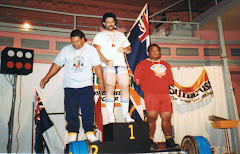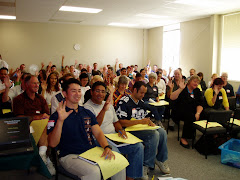For quite some years now I've been delivering a wide variety of trainings both here in NZ and internationally. I have at times, been asked to have those in attendance to complete a training feedback form. These are usually given out at the end of the training and filled out prior to them leaving and are handed in as they exit the training room. They are then passed onto the organisations training assessors who asked for the training to be delivered. These feedback forms are usually used as an indication as to whether the training was of any significant value to those who attended and the organisation who paid for its delivery. I'm sure most of you would have had something similar handed to you at the end of a training, if you've attended a corporate training recently.
Are these feedback sheets of any real value at all? That's the question I have asked myself over the years - right up to the present time. Do they have any real credence and value at all or not? That's what I'm going to cover in this blog.
A Scenario
Let's say the HR Department and more specifically the HR Professional Development Advisers (or similar) want to asses if the training they have contracted in is worthwhile, appropriate, effective and achieves the desired goals for those staff in attendance.
So... they devise a feedback form with questions on it like:
- Was the training you received relevant to your job?
- Were you engaged by the presenters?
- Would you encourage other staff to attend this training in the near future?
The questions may be answered on a 1-7 continuum. Scoring a 1 for very poor delivery and a 7 for an excellent delivery.
I'm sure you have the idea now so let's move on.
The Happy Sheet Problem!
In my own opinion these feedback sheets are an absolute waste of time - why? (I'll try to keep my answer to a minimum).
- The forms are devised by people who have likely never made a presentation of any real note in their lives! They have no idea what is or is not an effective training or how to measure one!
- Those attending the training have little or no knowledge themselves, on how to effectively benchmark a trainer and their delivery style.
- Those receiving and interpreting the feedback forms never attended the training themselves.
- Filling out the forms truthfully is limited by the degree of expertise by those in attendance. Their inability to judge what is a good presentation or not.
- If the trainer was in fact "poor" they realise that their comments could negatively impact the trainer and prefer to soften the blow by raising their feedback score in favor of the "poor" trainer!
- The trainer could use a "high" emotional close which positively impacts on the participants ability to give the presenter a "real" score and scores them instead on how well they finished the days presentation and they score them high.
- The feedback forms results are twisted by those interpreting them to suit the outcome they want, based on whether they actually like or dislike the trainer themselves.
- The timing of the feedback form is at the point of having just received the learning without any time for actual integration of the learning. Any real application of the learning and its effectiveness is weeks away yet.
- When the trainer knows what they're being measured against in the happy sheet all they do is meet those requirements, point out tactfully how they have done that for the group, yet not necessarily covered any of the core competencies needed for the group in attendance!
- If they have been on similar training before, the participant may score the presenter and content low, based on this and have missed what was presented that they didn't know, which would have made the difference to this person. Who only listened for what they knew and not what they didn't know.
- If those in attendance are trainers or tutors, they will likely give feedback that is based on their preferred presentation likes and dislikes, which may or may not be accurate due to their personal bias.
- If the participant has a bias for activities, sweets, handouts, multi-media, colored pens, music, culture, introductions, workbook style of manuals etc... and they are or are not available then the trainer is scored down. Which may not have been an ind
ication that the trainer wasn't good or bad at all
- The participants are asked to fill out the form at the end of the training when they want to get away home as soon as possible. Resulting in a simplistic and rushed feedback result by those filling them out.
- The Organisation or HR Department set a standard to determine if the training is good or bad not taking into count all the variables that are not recorded that directly influence a persons training experience and the score they give at the end of the day i.e. room temperature, external noise, quality of food at breaks, availability of their preferred hot drink, lunch provided or not and the quantity available, seats comfortable or not, car parking location and cost, ease of finding the room, stairs to climb, access to be able to have a smoke in their breaks and ease of access to toilets etc... (all of these factors need to be considered as they affect the score which can negatively affect the trainers score)
A Different Approach
I've listed here some important factors that need to be present for a more accurate approach in measuring a trainings effectiveness. I have met NO training assessment that has utilised these points to determine whether a training is effective or not. At best they may have 1 of the points I've listed below!
- Have an assessor sit in on the entire training, who is skilled and knowledgeable in training delivery and who has an established training delivery benchmark template from which they are able to effectively provide feedback based on the behavioural benchmarks specifically set for training delivery.
- Use a benchmark criteria that is sensory/behaviourally based assessment of key core competencies of training delivery i.e. engagement, rapport, platform skills, vocal variety that are also relevant to the content and the room the training is delivered in (i.e. A small room with no break-out space, will radically limit the ability for activity based delivery as would an audience seated in a lecture room ampi-theatre setting. How can you accurately judge this trainer against another in a different training environment?).
- A pre and post training evaluation is taken by those attending to determine the degree of learning that has taken place. What did they know about the subject prior to attending and how much knowledge & skill development have they gained after the training and weeks later.
- Make sure those interpreting the results actually are highly skilled trainers themselves.
- The assessor is to have no conflict of interest in whether the trainer is scored well or not. That is, the assessor has no personal gain from scoring the trainer high or low.
- A longitudinal study over 2, 5 and 7 weeks is done on what the participants have taken away and implemented from the training and this is scored to determine a post training result.
- A percentage feedback score minimum of 85% to be set once the benchmarks have been established for the training. The 85% score is to be achieved as an average, in each of the core benchmark competencies that are relevant to the content delivered. Be aware that the scoring of the trainer and the core competencies need to change, should the training content and venue change. The use of the same feedback sheet for all trainings and trainers within the organisation is a sure sign, that the system being used is of a poor standard, in assessing accurately, whether a training is or is not effective.

Ok. There you have it.
Happy sheets, although popular and used by many organisations, in the hope they will gain insight to the overall result of a training delivered. It is highly unlikely it is accurate or has any real depth of quality. I do know, that this can be greatly improved by making the changes I have offered above and many more. My guess is that very few will be willing to make the required changes, and will continue making many of the mistakes I have listed in the Happy Sheet problems listing.
If you want to get your training assessment right and achieve no less than 85% plus satisfaction success rate by your participants, with your professional development training - email me: colin@ignition.org.nz


















































No comments:
Post a Comment